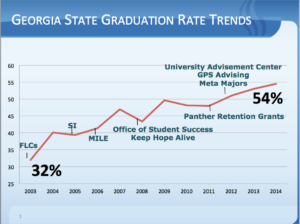

Photo submitted by Carol Cohen | Director of University Advisement Center
Students have been handed a one-way ticket to graduation with Georgia State’s new system.The new system makes early intervention easier by utilizing data and analytics to stay abreast of the academic progress of Georgia State students.
Associate Vice President for Student Success Allison Calhoun-Brown says that student success is the number one goal of Georgia State’s strategic plan.
“Georgia State is taking concerted action action to keep students on path for graduation and using data to give our more than 30,000 undergraduate students the same kind of intensive academic guidance that is often only found at much smaller institutions. It is a high tech, high touch approach to academic advisement and it seems to be working,” Brown said.
He said the university is able to identify through more than 700 indicators when a student may be going off-track in their courses. And this system has so far caught over 2,000 registration errors. It almost works like a car’s GPS system, Brown said, as it alerts an academic advisor as soon as it catches a registration mistake.
Vice President for Enrollment Management & Student Success Dr. Timothy M. Renick said the system is designed to reach out to students that are struggling academically by using analytical and predictive data to identify them.
“The issues that are identified include students who register for courses who don’t apply to their degree programs, students who underperform in their prerequisite classes and students who have academic trouble in the early weeks of the semester,” Renick said.
“Since we launched the system in 2012, Georgia State has raised four-year graduation rates by nine percentage points and lowered the average time to degree for graduating seniors by more than half a semester and last year, Georgia State advisors in the University Advisement Center initiated more than 51,000 face-to-face meetings with students to discuss such alerts and help to get students back on track for graduation,” Renick said.
The system and the alerts have increased Georgia State’s four-year graduation rates by allowing students to save some tuition money by completing all of their requirements quicker and with fewer wasted credit hours.
University Advisement Center Director Carol Cohen says when academic advisors utilize the Graduation and Progression Success system they are able to retrieve data, use the predictive analytics, and know exactly when a student goes off-track by various markers the system sends.
“The system helps the academic advisor in a systematic way by using the predictive analytics to direct students in the quickest path towards graduation and without missed coursework. The system updates nightly and when the system alerts a change via a marker, academic advisors generally contact students within 24 to 48 hours via email,” Cohen said.
The predictive analytics lets the University Advisement Center know which students are at risk for graduation. The advisement center proactively monitors students academic progress by setting certain markers in the system and contacting students when a marker has been reached. The markers help to minimize the risk of students under-performing.
“The system really targets at-risk students whose GPA is right around the 2.75 GPA, because some of these students may not come into the University Advisement Center due to self-advising however, this group falls right in-between students who are on academic probation and students who are doing well and our goal is to see these students improve,” says Cohen.
The system allows students to save money by not taking excess classes and by not taking classes which aren’t geared towards a student’s major.
“The number of excess credit hours that students take beyond what is needed for graduation has fallen by eight hours in the last couple of years. This means that students are taking about a half of a semester less time and spending a half of semester less money to complete their degree,” said Brown.
Saving money is a big necessity for students as college tuition has been high across the country. Some students are getting through their college years by working multiple various jobs to afford tuition.
“Students in the graduating class of 2016 saved about $15 million in tuition me fees compared to the class of 2013 by completing all of their requirements more quickly and with fewer wasted credit hours,” Renick said.
As a result of this new system, the University Advisement Center now has more tools and information at their fingertips to assist students in getting real live data on information as it relates to potential jobs in their field of study. The system also utilizes different departments to work together to ensure students are taken care of academically and professionally.
